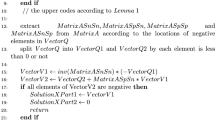Abstract
The present paper studies the linear complementarity problem of finding vectorsx andy inR n+ such thatc + Dx + y ≧ 0,b − x ≧ 0 andx T (c + Dx + y) = y T (b − x) = 0 whereD is aZ-matrix andb > 0. Complementarity problems of this nature arise, for example, from the minimization of certain quadratic functions subject to upper and lower bounds on the variables. Two least-element characterizations of solutions to the above linear complementarity problem are established first. Next, a new and direct method to solve this class of problems, which depends on the idea of “least-element solution” is presented. Finally, applications and computational experience with its implementation are discussed.
Similar content being viewed by others
References
J. Céa and R. Glowinski, “Sur des méthodes d'optimisation par relaxation”,Revue Francaise d'Automatique Informatique et Recherche Opérationnelle R-3 (1973) 5–31.
R. Chandrasekaran, “A special case of the complementarity pivot problem”,Opsearch 7 (1970) 263–268.
J.C. Cheng, “Analysis of a quantum price model in commodity futures markets and a fair salary administration system”, Ph.D. Dissertation, Department of Mathematics, MIT (September 1975).
R.W. Cottle and G.B. Dantzig, “Complementarity pivot theory of mathematical programming”,Linear Algebra and Its Applications 1 (1968) 103–125.
R.W. Cottle and M. Goheen, “On a special class of large quadratic programs”, Technical Report SOL 76-7, Systems Optimization Laboratory, Stanford University (April 1976).
R.W. Cottle and J.S. Pang, “On solving linear complementarity problems as linear programs”,Mathematical Programming Study 7 (1978) 88–107.
R.W. Cottle, G.H. Golub and R.S. Sacher, “On the solution of large, structured linear complementarity problems: III”, Technical Report 74-7, Department of Operations Research, Stanford University (1974).
R.W. Cottle and A.F. Veinott Jr., “Polyhedral sets having least elements”,Mathematical Programming 3 (1969) 238–249.
C.W. Cryer, “The solution of a quadratic programming problem using systematic overrelaxation”,SIAM Journal on Control 9 (1971) 385–372.
M. Fiedler and V. Pták, “On matrices with nonpositive off-diagonal elements and positive principal minors”,Czechoslovak Mathematical Journal 12 (1962) 382–400.
I. Kaneko, “Isotone solutions of parametric linear complementarity problems”,Mathematical Programming 12 (1977) 48–59.
I. Kaneko, “A linear complementarity problem with ann by 2n “P”-matrix”,Mathematical Programming Study 7 (1978) 120–141.
D.P. O'Leary, “Hybrid conjugate gradient algorithms”, Ph.D. Dissertation, Computer Sciences Department, Stanford University (1975).
O.L. Mangasarian, “Linear complementarity problems solvable by a single linear program”,Mathematical Programming 10 (1976) 263–270.
O.L. Mangasarian, “Solution of linear complementarity problems by linear programming”, in: G.W. Watson, ed.,Numerical analysis, Dundee 1975, Lecture Notes in Mathematics, No. 506 (Springer-Verlag, Berlin, 1976) pp. 166–175.
J.S. Pang, “On a class of least-element complementarity problems”, Technical Report SOL 76-10, Systems Optimization Laboratory, Stanford University (June 1976).
J.S. Pang, “Least-element complementarity theory”, Ph.D. Dissertation, Department of Operations Research, Stanford University (September 1976).
J.S. Pang, “A new characterization of realH-matrices with positive diagonals”,Linear Algebra and its Applications, to appear.
B.T. Polyak, “The conjugate gradient method in extremal problems”,U.S.S.R. Computational Mathematics and Mathematical Physics 4 (1969) 94–112.
R.S. Sacher, “On the solution of large, structured complementarity problems”, Ph.D. Dissertation, Department of Operations Research, Stanford University (1974).
R. Saigel, “A note on a special linear complementarity problem”,Opsearch 7 (1970) 175–183.
H. Samelson, R.M. Thrall and O. Wesler, “A partitioning theorem for Euclideann-space”,Proceedings American Mathematical Society 9 (1958) 805–807.
F. Scarpini, “Some algorithms solving the unilateral Dirichlet problem with two constraints”,Calcolo 12 (1975) 113–149.
A. Tamir, “The complementarity problem of mathematical programming”, Ph.D. Dissertation, Department of operations Research, Case Western Reserve University (June 1973).
A.F. Veinott Jr., “Leastd-majorized network flows with inventory and statistical applications”,Management Science 17 (1971) 547–567.
A.F. Veinott Jr., Unpublished class notes, Department of Operations Research, Stanford University.
Author information
Authors and Affiliations
Additional information
Research partially supported by the National Science Foundation Grant MCS 71-03341 A04 and the Air Force Office of Scientific Research Contract F 44620 14 C 0079.
Rights and permissions
About this article
Cite this article
Pang, JS. On a class of least-element complementarity problems. Mathematical Programming 16, 111–126 (1979). https://doi.org/10.1007/BF01582097
Received:
Revised:
Issue Date:
DOI: https://doi.org/10.1007/BF01582097




